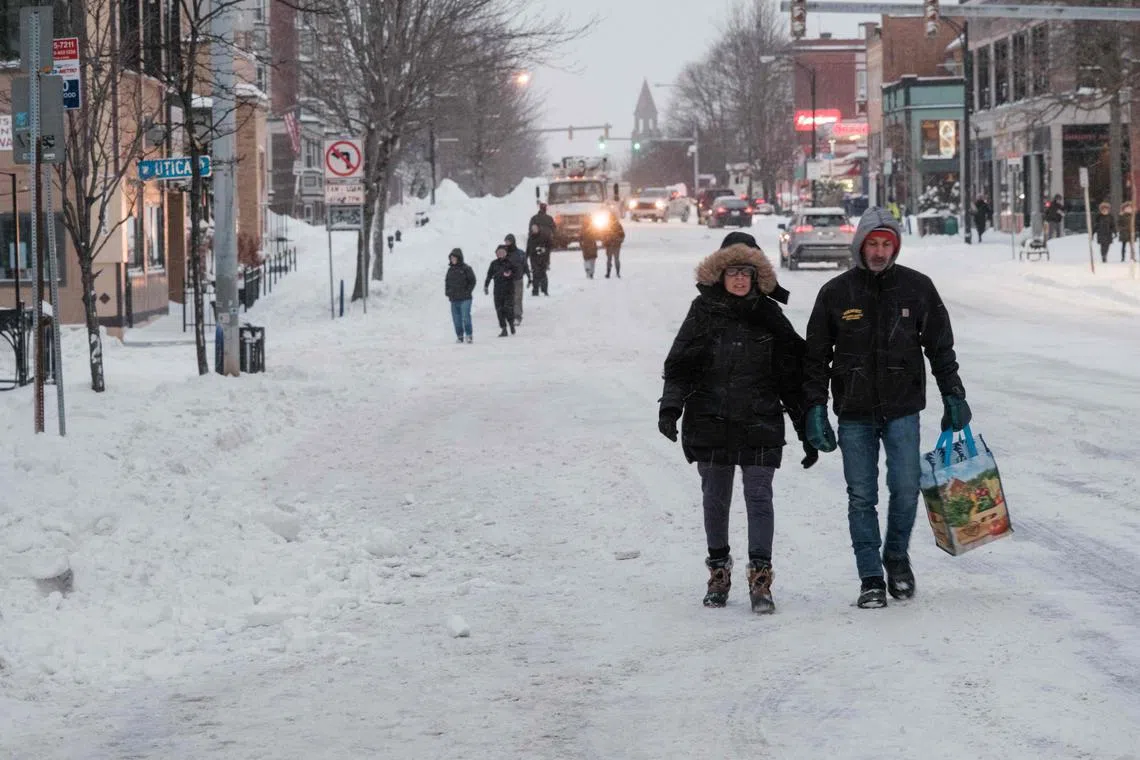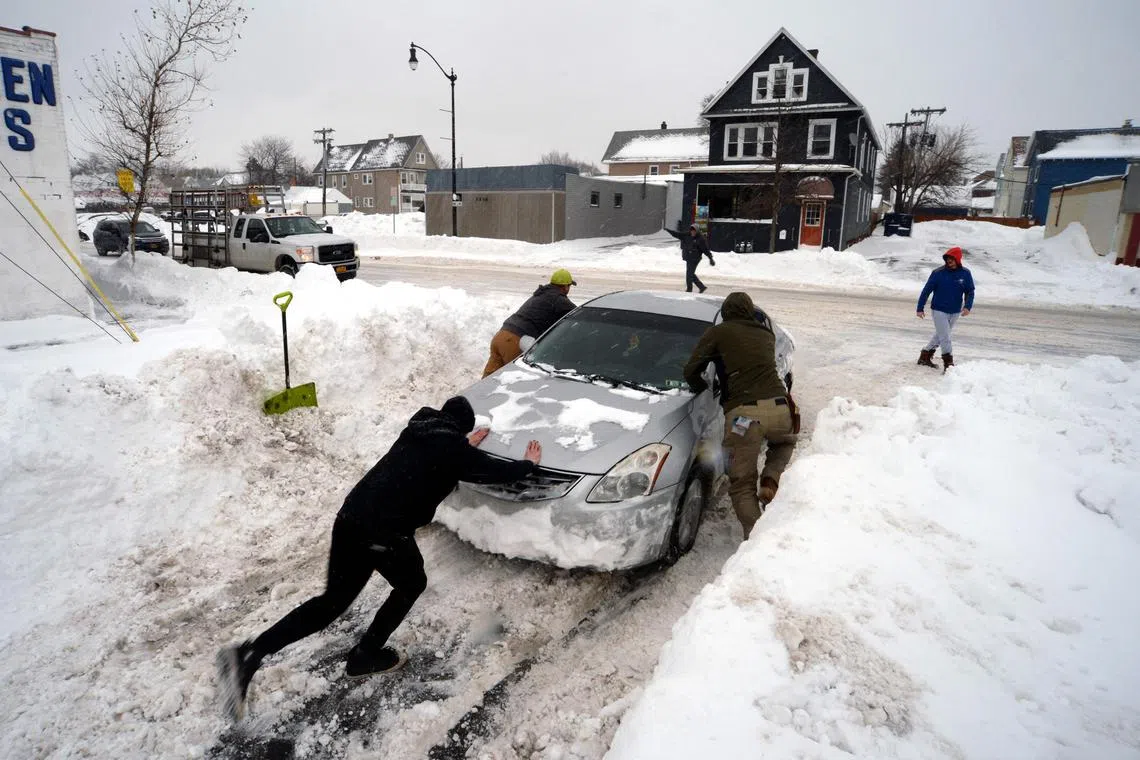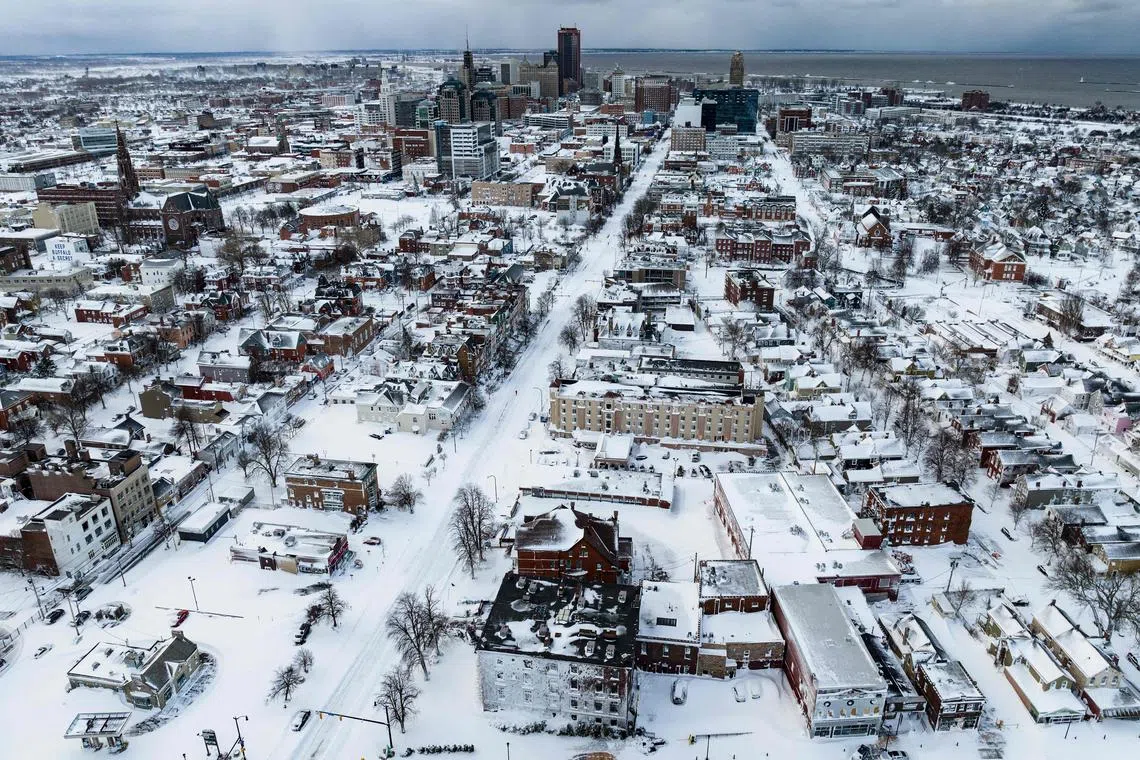Western New York digs out from blizzard, warming could bring rain, slush
Sign up now: Get ST's newsletters delivered to your inbox

Across the country, at least 60 lives have been lost in weather-related incidents in recent days.
PHOTO: AFP
Follow topic:
BUFFALO, New York - Storm-weary road crews and residents of western New York struggled on Tuesday to dig out from a deadly weekend blizzard.
Snow was still falling, amid forecasts for rapid warming and rains that could cause flooding and turn the frozen landscape to slush.
The region in and around Buffalo, New York, downwind of Lake Erie and Lake Ontario, emerged as ground zero for an Arctic deep freeze
Confirmed storm-related deaths in New York’s Erie and Niagara counties rose to 32 on Tuesday, officials said, as snowfall began to taper off. Emergency crews continued locating and removing vehicles left buried under deep mounds of snow and metres-high drifts.
Some people were found frozen to death in cars, others in snowbanks outdoors, while some died in medical emergencies such as cardiac arrest while shovelling snow, Erie County’s chief executive Mark Poloncarz told reporters.
“We’re recovering from the worst storm I’ve ever seen, certainly in terms of death from mother nature’s wrath,” he said.
Nationwide, at least 60 died in weather-related incidents in recent days, NBC News reported.
In and around Buffalo, up to 132cm of snow fell over four days and a bit more was expected by Tuesday night, according to the National Weather Service (NWS).
The situation was expected to change dramatically. The NWS forecast a rapid thaw later this week, with temperatures climbing well above freezing and well above normal, accompanied by rain that could unleash flooding.
“With 50-degree (10 deg C) temperatures and rain later this week, we are working with our NWS Buffalo partners to monitor the forecast,” Mr Poloncarz said in a Tweet. “This is one of the reasons certain streets are targeted for extra clearance to allow for proper drainage of meltwater.”
Progress was slow due to the sheer volume and depth of the snow, which Mr Poloncarz said “is not ploughable”.
Special high-lift shovel tractors were brought in to scoop up snow into dump trucks, which then cart away the frozen loads to be discarded elsewhere.
Mr Poloncarz said it would take two days to open up one lane on every city street.
Giant snow-blowing machines were also deployed to help clear several major highways clogged with towering drifts.
A ban on personal road travel was still in effect for Buffalo.
Hundreds of electric company linemen were out restoring power, and Mr Poloncarz said on Twitter that about 4,500 customers remained without electricity on Tuesday, as crews cleared downed trees with chainsaws.
For residents essentially trapped in their homes for two days, the easing of the storm finally brought a realisation of how much snow fell during white-out conditions that had limited their view.
“We would look out the window and it was blowing so much that we couldn’t really tell if we were getting any accumulation, but when it finally settled we had a lot of work to do,” said Jim Nowak, who was out shovelling on Tuesday.

Residents help to push out a car along South Park Avenue in Buffalo, New York, on Dec 27, 2022.
PHOTO: AFP
NWS meteorologist Bob Oravec of the NWS Weather Prediction Centre in Maryland predicted five more centimetres would fall in Western New York on Tuesday, but said that was probably the last.
“It’ll be warming up soon. By Thursday, the high will be 46 (8 deg C). By Saturday, it’ll be 54 (12 deg C),” Mr Oravec said.
Tuesday remained cold, with a high of -2 deg C and a low of -6 deg C, Mr Oravec said.
Buffalo, New York state’s second-largest city, was hardest hit by the blizzard, which took shape over the Great Lakes on Friday and extended its grip into the Ohio and Upper Mississippi valleys and mountains of Appalachia.
New York Governor Kathy Hochul called it an “epic, once-in-a-lifetime” weather disaster, the worst blizzard to hit the Buffalo area in 45 years.

Buffalo, New York state’s second largest city, was hardest hit by the blizzard.
PHOTO: AFP
The county has called in 100 military police from the state National Guard as well as officers from New York City to help manage traffic and enforce road restrictions.
Buffalo residents with ploughs attached to their Jeeps and pickup trucks helped clear side streets. People walked 1.5km or more in the lanes cut by snow ploughs to reach convenience stores and supermarkets that were beginning to reopen.
Mr Poloncarz, speaking at a press briefing Tuesday, urged residents to stay home and the curious to stay away.
“Please stay out of the city of Buffalo,” he said. REUTERS

